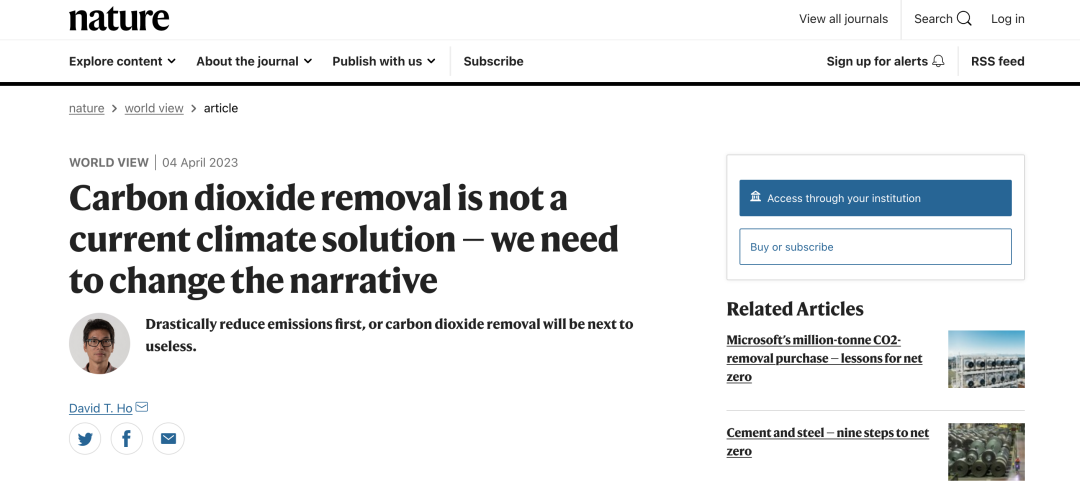CO2 removal technology is not the current climate solution

Main content:
Carbon dioxide removal (CDR) technology turns "net" into "net zero". According to the Intergovernmental Panel on Climate Change (IPCC), all pathways to limit global warming to 1.5°C-2°C above pre-industrial levels will need to be rapidly decarbonized from now on. Carbon dioxide needs to be removed from the atmosphere at the same time, as it is impossible to completely eliminate carbon emissions within a specified period of time. Even in the most optimistic scenario, "hard-to-abate" sectors such as aviation and shipping will remain a major source of greenhouse gases, which will mean that we will not be able to meet our net-zero targets, so we will need CDRs to achieve them. The way trees are planted or maintained to remove carbon dioxide from the atmosphere and store it in the ground, in the ocean, or in products will last longer.
Against this backdrop, companies are springing up to apply various CDR technologies as a solution to today's climate. Other countries are enthusiastically buying carbon credits – essentially investing in tree planting, or other future carbon credits – as part of their current decarbonization commitments.
I've spent my career studying the natural carbon cycle, and in recent years, I've been researching ways to test whether CDRs work. I'm a reviewer for the $100 million XPRIZE carbon removal competition funded by the Musk Foundation, and I've reviewed dozens of proposals. I do not deny the need to develop a CDR approach for the long term. I welcome the much-needed resources provided by Governments in this area. Direct Air Capture (DAC) technology chemically absorbs carbon dioxide from the atmosphere, and after some small-scale demonstrations, the 2022 Bipartisan Infrastructure Act invested $3.5 billion in the development of four DAC centers. But I'm well aware that it makes no sense to deploy them and thus try to remove carbon dioxide from the atmosphere until society completely cancels its polluting activities.
Time travel
To understand why, think of CDR as a time machine. Take, for example, the proposed DAC Center in the United States. Each facility is eventually expected to extract 1 million tonnes of CO2 per year.
In 2022, 40.5 billion tonnes of carbon dioxide were emitted globally. At this rate, for every year of operation at full potential, each center will set the atmosphere back by nearly 13 minutes, but in the time it takes to remove those 13 minutes of carbon dioxide, the world will emit a full year of carbon dioxide into the atmosphere.
At the same time, if every person on the planet planted one tree, that would be 8 billion trees. Once the trees are ripe, they will take us back about 43 hours a year.
The time machine analogy reveals just how useless CDR is at the moment. So we have to change that mindset. In the coming years, there will be an influx of money into climate solutions, and we need to channel it well. At a time when emissions are still high, we must stop talking about CDR as a solution – as if it somehow replaced radical, immediate emissions reductions.
Back to the future
If we can successfully decarbonize in the next 20-30 years, the situation will be completely different.
If we reduce emissions to about 10% of current levels, which is 4 billion tons of CO2 per year, then a DAC plant capable of removing 1 million tons of CO2 would be a time machine that will take us back more than 2 hours instead of 13 minutes. At that point, assuming these facilities are powered entirely by renewable energy, 4,000 facilities will need to reach net-zero emissions in any given year.
In fact, the remaining emissions could be 18% of the current total, so we must significantly scale up our CDRs to reach net zero. But it may be feasible to build a 7290 DAC hub or deploy other CDR technologies.
At the same time, research is needed to seek CDR methods that minimize land use and energy consumption, and that can be scaled up quickly and cheaply. It's critical to do that now so that we can have the technology available in the future, when it works, when it can be used to eliminate legacy emissions to address intergenerational equity.
Not all techniques that work in the lab will work in the real world. Some can have a heavy cost to biodiversity and the environment. Developing methods to validate the effectiveness of CDR is a major challenge. It will take many years for science to tell us which methods work and whether they are harmful or beneficial to the environment.
Humans have never removed any kind of air pollutant on a global, continental, or even regional scale – we have simply shut down the source of the pollution and let nature clean it up. This is true of chlorofluorocarbons and stratospheric ozone depletion, sulphur dioxide and acid rain, sulphur and nitrogen oxides, and photochemical smog. We must be prepared for the failure of CDR and allow us to rely on the environment to stabilize carbon dioxide in the atmosphere for thousands of years. This is another reason to support rapid decarbonization.
The scale of the challenge is enormous. We have to slow down the carbon clock to get it to turn back.







